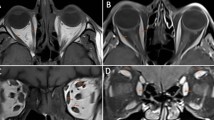Abstract
Objective
To investigate anatomic features of the inferior oblique nerve (IObN) by high-resolution magnetic resonance (MR) imaging and cadaveric dissection.
Methods
This study enrolled 100 consecutive outpatients, who underwent 3.0 T MR imaging equipped by the 32-channel head coil. The T2-weighted imaging data of IObN were extracted for analysis and compared with the findings of microsurgical dissection in 14 orbits.
Results
50 male and 50 female subjects allotted to the imaging study were aged from 11 to 78 years. In 94 % sides, the IObN was found to separate from the inferior rectus muscle (IRM) at the level just behind to the posterior pole of the bulb. At the midpoint of the IObN part coursing along the orbital floor and above or adjacent to the infraorbital nerve and artery complex, the mean distance from the lateral margin of the IRM was 1.0 mm on the right and 0.9 mm on the left. The IObN showed upward direction change just below the belly of the inferior oblique muscle and innervated to it at the equator level in 78 sides on the right and 89 on the left. Dissected specimens revealed the consistent morphological findings of the IObN.
Conclusions
The IObN seems to be a relatively consistent structure. Anatomic information on the IObN and surrounding structures that are provided by high-resolution MR imaging can be a help for safe surgery.






Similar content being viewed by others
References
Demer JL, Dushyanth A (2011) T2-weighted fast spin-echo magnetic resonance imaging of extraocular muscles. J AAPOS 15:17–23
Erdogmus S, Govsa F, Celik S (2007) Innervation features of the extraocular muscles. J Craniofac Surg 18:1439–1446
Georgouli T, Chang B, Nelson M, James T, Tanner S, Shelley D, Saldana M, McGonagle D (2008) Use of high-resolution microscopy coil MRI for depicting orbital anatomy. Orbit 27:107–114
Gönül E, Erdogan E, Düz B, Timurkaynak E (2003) Transmaxillary approach to the orbit: an anatomic study. Neurosurgery 53:935–942
Gönül E, Timurkaynak E (1998) Lateral approach to the orbit: an anatomical study. Neurosurg Rev 21:111–116
Jensen AA, Young TL (2002) Inferior oblique muscle palsy following maxillectomy for squamous cell carcinoma. J AAPOS 6:51–53
Jiao YH, Zhao KX, Wang ZC, Qian XH, Wu X, Man FY, She HC (2009) Magnetic resonance imaging of the extraocular muscles and corresponding cranial nerves in patients with special forms of strabismus. Chin Med J 122:2998–3002
Kaza E, Klose U, Lotze M (2011) Comparison of a 32-channel with a 12-channel head coil: are there relevant improvements for functional imaging? J Magn Reson Imaging 34:173–183
Kazkayasi M, Ergin A, Ersoy M, Tekdemir I, Elhan A (2003) Microscopic anatomy of the infraorbital canal, nerve, and foramen. Otolaryngol Head Neck Surg 129:692–697
Kumar V, Murlimanju BV, Devika P, Nair N, Pai SR, Pulakunta T, Naveen NS (2011) An anatomical study of the inferior oblique muscle with emphasis on its nerve entry. Chang Gung Med J 34:293–297
Lim LS, Yang X, Gazzard G, Lin X, Sng C, Saw SM, Qiu A (2011) Variations in eye volume, surface area, and shape with refractive error in young children by magnetic resonance imaging analysis. Invest Ophthalmol Sci 52:8878–8883
Ozer MA, Celik S, Govsa F (2009) A morphometric study of the inferior orbital fissure using three-dimensional anatomical landmarks: application to orbital surgery. Clin Anat 22:649–654
Paik DJ, Shin SY (2009) An anatomical study of the inferior oblique muscle: the embalmed cadaver vs the fresh cadaver. Am J Ophthalmol 147(544–549):e1
Rhoton AL Jr (2002) The orbit. Neurosurgery 51(4 Suppl):S303–S334
Stager DR (2001) Costenbader lecture. Anatomy and surgery of the inferior oblique muscle: recent findings. J AAPOS 5:203–208
Zhang Y, Liu H, Liu EZ, Lin YZ, Zhao SG, Jing (2010) Microsurgical anatomy of the ocular motor nerves. Surg Radiol Anat 32:623–628
Acknowledgments
This work was not supported by any grant. We thank Professor Rhoton AL Jr for supporting every aspect of the cadaveric study of the present work performed in the Department of Neurological Surgery, University of Florida, USA.
Conflict of interest
The authors have no conflict of interest concerning the materials or methods used in this study or the findings specified in this paper.
Author information
Authors and Affiliations
Corresponding author
Rights and permissions
About this article
Cite this article
Tsutsumi, S., Nakamura, M., Tabuchi, T. et al. An anatomic study of the inferior oblique nerve with high-resolution magnetic resonance imaging. Surg Radiol Anat 35, 377–383 (2013). https://doi.org/10.1007/s00276-012-1040-x
Received:
Accepted:
Published:
Issue Date:
DOI: https://doi.org/10.1007/s00276-012-1040-x




